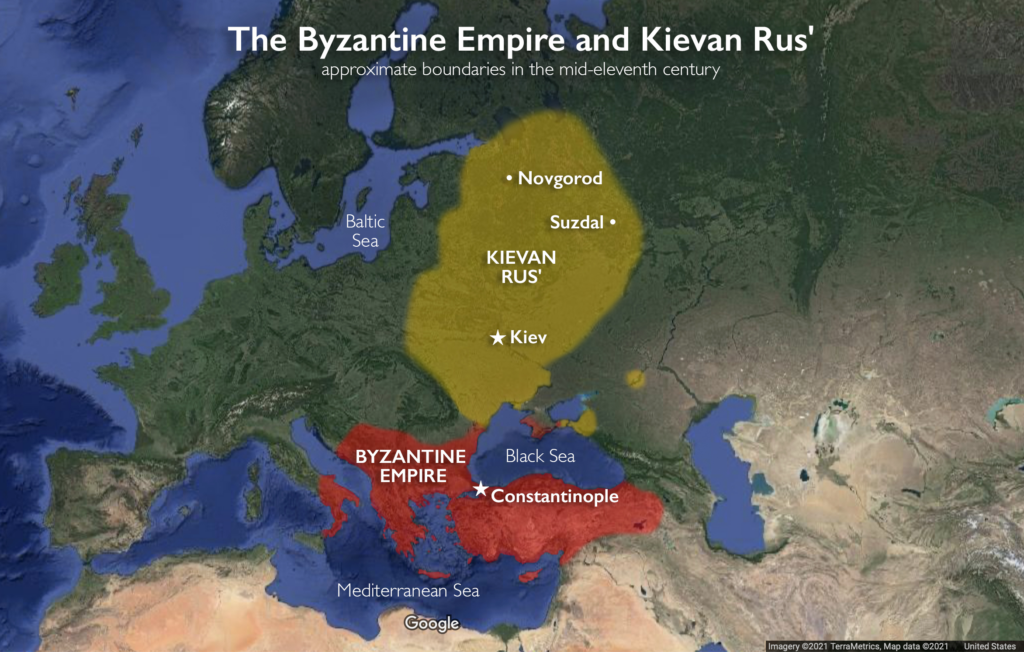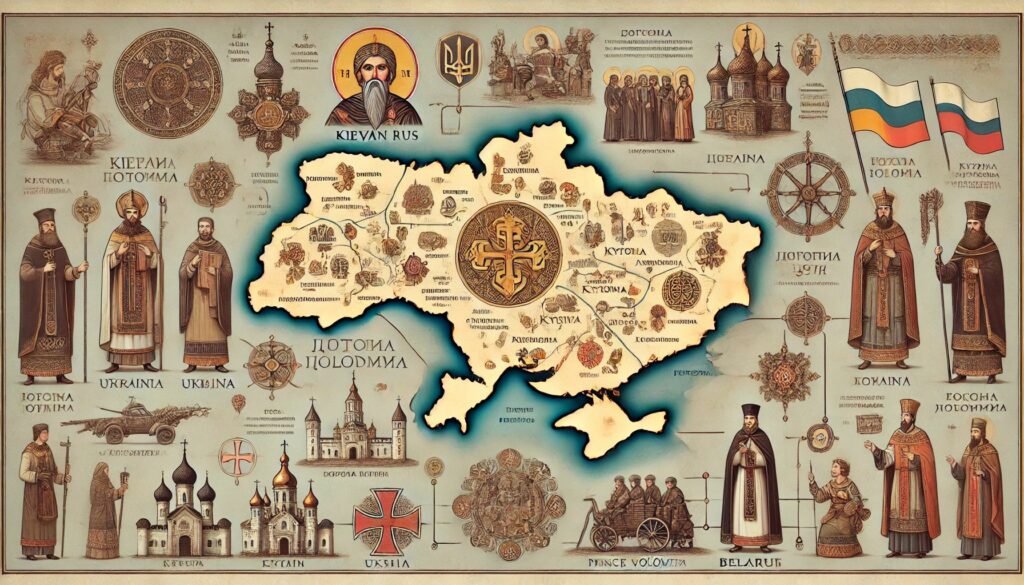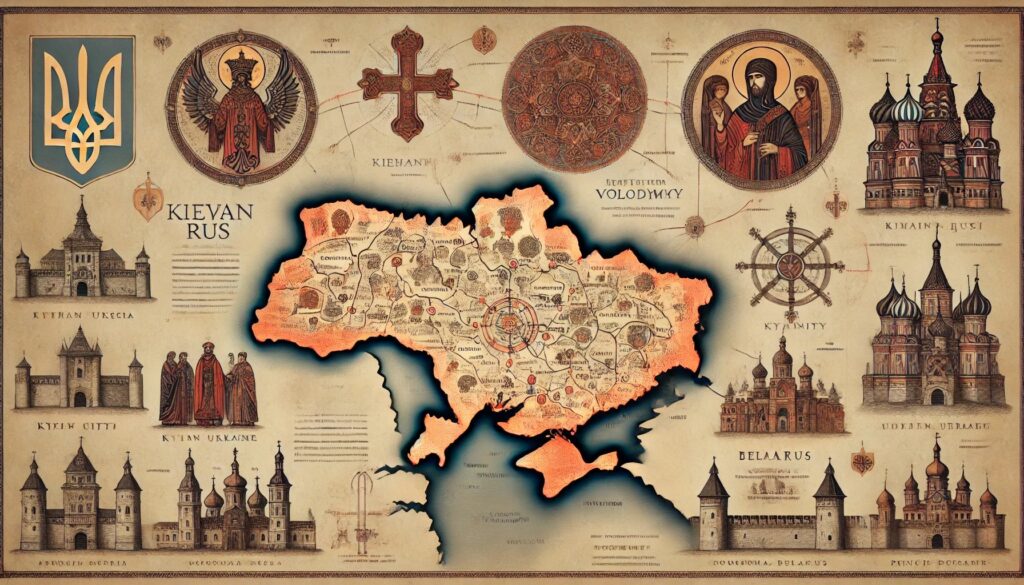
- President Vladimir Putin refers to the Idea of Kievan Rus as a “civilizational choice” which shaped the future of Russians, Ukrainians, and Belarusians.
- The kingdom of Kievan-Rus was founded in the location of the contemporary Ukrainian capital city Kyiv in the ninth century by Viking warrior traders from Scandinavia who mixed with the local Slavic population.
- Protection of Russian compatriots abroad and in neighbouring countries also figures prominently in the 2013 Concept of the Foreign Policy of the Russian Federation.
- Ukrainian nationalists believe that Ukrainians constitute a distinct nation that should have their state emerged during the nineteenth century.
Introduction
Russian leaders throughout history have always held the unshakable conviction that they must “collect the Russian lands,” sometimes referred to as the land of the Rus. Some scholars also used the term “Greater Russia” which we can also trace back to Kievan-Rus. Kievan-Rus was a historical kingdom in Eastern Europe from the 9th to the 13th century. The three modern states—Belarus, Russia, and Ukraine—cite Kievan Rus as their common ancestry. Due to its unique culture, Kievan Rus became a strong idea for understanding the history of contemporary Russia, Belarus and Ukraine. The adoption of Orthodox Christianity was a crucial moment in Kievan Rus’s history and helped shape the Kingdom’s culture and identity.
The idea of a strong and centralised state, which was one of the unique characteristics of Kievan-Rus, is also reflected in the political system of modern Russia. President Vladimir Putin refers to the Idea of Kievan Rus as a “civilizational choice” which shaped the future of Russians, Ukrainians and Belarusians. It created an Orthodox Russian realm that was separate from the Latin, Roman Catholic world, which he refers to as a “common spiritual space”. President Putin appropriates a new foreign policy doctrine based on the concept of a “Russian World”, a notion that conservative ideologues have used to justify intervention abroad in support of Russian speakers. This article tries to explain how Russian President Putin justifies his policies in Ukraine through the narrative of Kievan-Rus.
Historical Overview
To justify Russia’s military invasion of Ukraine in February 2022, President Putin has repeatedly referred to what Russians call the Kievan – Rus. Putin sees this Orthodox Christian medieval Kingdom which cantered around the contemporary Ukrainian capital, Kyiv, as the common point of origin for both Russians and Ukrainians. On July 12th, 2021, the Kremlin’s official website published an article by Russian President Vladimir Putin called “On the Historical Unity of Russians and Ukrainians’’. This article provides a key guide that shapes Putin’s and many Russian attitudes toward Ukraine. In this article, Putin argues that present-day Russians, Ukrainians, and Belarusians are descendants of the medieval orthodox kingdom of Kievan- Rus. Hence Putin believes that Russia, Ukraine, and Belarus are “brother nations” with one group called Velikorossy (“Great Russians’’), the second group the Ukrainians called Malorossy (“Little Russians’’) and the third group the Belarusians called Belorusy or “White Russians”.
It is important to understand the origins and decline of Kievan- Rus and the status of Ukraine under the different Russian Empires to explain the current Russian regime’s invasion of Ukraine in February 2022. The kingdom of Kievan-Rus was founded in the location of the contemporary Ukrainian capital city Kyiv in the ninth century by Viking warrior traders from Scandinavia (also called Varangians or Rus) who mixed with the local Slavic population. Slavics are an ethnic and linguistic group of people in Eastern Europe, they are further divided into three groups Eastern Slavic (mainly Russians, Ukrainians, and Belarusians), Western Slavic (Poles, Czechs, Slovaks, and Wends, or Sorbs) and South Slavs (Serbs, Croats, Bosnians, Slovenes, Macedonians, and Montenegrins). As per religion is concerned, the Slavs are traditionally divided into two main groups: those associated with the Eastern Orthodox Church (Russians, most Ukrainians, most Belarusians, most Bulgarians, Serbs, and Macedonians) and those associated with the Roman Catholic Church (Poles, Czechs, Slovaks, Croats, Slovenes, some Ukrainians, and some Belarusians).
In 988 CE, Slavic Grand Prince Volodymyr the Great, the pagan prince of Novgorod and Grand Prince of Kyiv adopted Orthodox Christianity from Byzantium and was baptized in the Crimean city of Chersonesus. Hence Kievan-Rus became part of the Orthodox Christian world. Russian President Vladimir Putin refers to Prince Volodymyr’s conversion to Orthodox Christianity as a key event that shaped the future of Russians, Ukrainians, and Belarusians. Putin also believes that Kievan-Rus’s conversion to Orthodox Christianity created an Orthodox Russian space distinct from the Roman Catholic world as Kievan-Rus’s neighbouring populations such as the Poles and Lithuanians adopted Catholic Christianity from Rome.
In the 17th century, the war between the Polish-Lithuanian Commonwealth and the Tsardom of Russia brought former Kievan-Rus lands to the east of the Dnieper River under Russian imperial control.

The decline and disintegration of Kievan-Rus began with the invasion of Mongol troops in the 13th century. The western and southwestern parts of Kievan-Rus, which constitute most of the territory of today’s Ukraine and Belarus, were divided between the Grand Duchy of Lithuania and the Kingdom of Poland in the 16th century. It was during this period that the principality of Muscovy (Moscow) cantered around Russia’s current capital Moscow began to rise to prominence. When Moscow became a Tsardom the official shortened title of the ruler was tsar vseya Rusi “Tsars of all the Russia’s”. All those Russia’s stemmed from the various principalities and successor states of the original Kievan-Rus. Hence the Tsars of Moscow considered themselves to be the legitimate rulers of the former Kievan -Rus lands. The Tsars of Moscow considered themselves to be defenders of the Orthodox Christian faith and they justified their interventions in the domestic affairs of neighbouring countries on the pretext that they were protecting believers of Orthodox Christianity. The Russian government today justifies invading Ukraine by claiming the need to protect the millions of ethnic Russians and Russian speakers living there.
In the 17th century, the war between the Polish-Lithuanian Commonwealth and the Tsardom of Russia brought former Kievan-Rus lands to the east of the Dnieper River under Russian imperial control. The east became known as “Left Bank” Ukraine; and the lands to the West of the Dnieper, or “Right Bank,” were ruled by Poland.
More than a century later, in 1793, right bank (western) Ukraine was annexed by the Russian Empire. In the years that followed, a policy known as Russification banned the study and use of the Ukrainian language and instead promoted the study and use of the Russian language. Following the Communist revolution of 1917 in Russia Ukrainians were one of several ethnic groups within the former Tsarist Russian empire to engage in a civil war for independence against Russia’s Communist Bolshevik government. However, following its military defeat in the civil war Ukraine was incorporated into the Soviet Union in 1922 as an autonomous Republic within the Soviet Union.
The Soviet Union like the Tsarist Empire Russian-dominated construct with the Ukrainian communist party as a puppet of the central authority in Moscow. During the Soviet era, Ukrainian culture and language were considered secondary to Russian which was the language of science, politics, administration, and urban centres. Ukraine’s political and cultural elites were either executed or sent to Moscow to serve the central Soviet administration.
Ukraine suffered immensely under Soviet leader Joseph Stalin. Stalin’s policies against private land ownership affected mostly Ukrainian-speaking peasants and his forced collectivization of agriculture led to a famine that killed more than four million people in Ukraine between 1932 and 1934. During the era of the Soviet Union, the Soviet authorities in Moscow repressed any ethno-nationalistic tendencies of Ukrainian nationalists as part of their agenda to break with Russia’s Tsarist past and to build a communist state where the communist ideology would form the basis of a stateless society and any form of ethnic nationalism was seen to be dangerous to the unity of the Soviet Union. Hence the Soviet government did not rely on the Tsarist narrative of Kievan-Rus to justify its control over Ukraine.
The collapse and disintegration of the Soviet Union in 1991 resulted in Ukraine becoming an independent state. The disintegration of the Soviet Union also created an ideological vacuum in the post-Soviet Russian Federation. The signing of the Belovezha Accords in December 1991 by the leaders of Russia, Ukraine, and Belarus signalled the annulment of the Soviet Union. The dissolution and disintegration of the Soviet Union in 1991 also created the problem of the millions of Russian speakers and ethnic Russians who became foreigners in newly sovereign states such as Ukraine. The problem of ethnic Russians and the ideological defeat of Communism at the end of the Cold War created conditions for the new Russian Federation to revive the Tsarist narrative of Kievan Rus to justify its intervention in neighbouring countries as the defender of ethnic Russians and Russian speakers.
Stalin’s forced collectivization of agriculture led to a famine that killed more than four million people in Ukraine between 1932 and 1934.

Protection of Russian compatriots abroad and in neighbouring countries also figures prominently in the 2013 Concept of the Foreign Policy of the Russian Federation. It underlines that “particular attention will be paid to providing support to compatriots living in the CIS Member states’’. Another aim will be to negotiate “agreements on the protection of their compatriots ensuring comprehensive protection of rights and legitimate interests of Russian citizens and compatriots residing abroad, and promoting, in various international formats, Russia’s approach to human rights issues”. This shows how the Tsarist narrative of Kievan-Rus is used by the current Russian regime to intervene in neighbouring countries on the pretext of defending the rights of ethnic Russians and Russian speakers in neighbouring countries if Russia perceives that they are being persecuted by the host country’s government. This pretext was used by President Vladimir Putin to justify Russia’s annexation of Crimea in 2014 as well as its military invasion of Ukraine in February 2022 and Russia’s subsequent annexation of the Russian-speaking regions of Ukraine such as Donetsk and Luhansk in 2022.
The centrality of Kievan-Rus to President Vladimir Putin’s worldview on Ukraine was seen in November 2016 when he gave a speech inaugurating a statue of Prince Volodymyr in Moscow. In this speech Putin stated that Prince Volodymyr had ‘gathered and defended Russia’s lands’ by ‘founding a strong, united and centralized state, incorporating diverse peoples, languages, cultures, and religions into one enormous family’. Putin in his speech further argues that the three modern countries that could trace their origins to Kievan-Rus – Russia, Ukraine, and Belarus were all members of this family. Putin in his speech further argues that Russians, Ukrainians, and Belarusians were a single people, or nation, sharing the same Christian principles, the same culture, and language, which formed the Slavic bedrock of the Russian empire and the Soviet Union.
Ukraine’s opposition to the Russian narrative of Kievan- Rus
Ukraine like Russia traces its origins to the medieval Orthodox Christian kingdom of Kievan- Rus. However, Russia’s use of the legacy of Kievan–Rus to justify its intervention in Ukrainian affairs to advance its interests has been opposed by Ukrainian nationalists because the inhabitants of Ukraine have maintained political and linguistic identities distinct from Russia for centuries. Ukrainian nationalists’ belief that Ukrainians constitute a distinct nation that should have their state emerged during the nineteenth century when the territories of the Polish Lithuanian Commonwealth including the Commonwealth’s Ukrainian territories were partitioned between the Tsarist Russian Empire Habsburg Austro-Hungarian Empire. The result of the partition the Austro-Austro-Hungarian controlled the western Ukrainian regions of Galicia, Bukovina, and Transcarpathia.
The narrative has enabled the current Russian President Vladimir Putin to claim that Ukrainian governments in the post-Soviet era have pursued a Bandera-like policy of eliminating Russian influence and persecuting ethnic Russians and Russian speakers in Ukraine.
Following the collapse of the Austro-Hungarian and Tsarist Russian empires, a as result of the First World War the Western Ukrainian territories previously controlled by the Austro-Hungarian empire passed under Polish or Romanian control by the early 1920s. However, it was not until the start of the Second World War that the Soviet Union seized those Ukrainian territories under Polish and Romanian control under the Molotov–Ribbentrop 1939. Despite the Soviet Union’s attempts to impose harsh collectivization measures, Western Ukraine emerged as a hotbed of Ukrainian nationalist sentiment. Western Ukraine was the base of operations for Stepan Bandera’s Organization Of Ukrainian Nationalists (OUN), which attempted to set up a puppet Ukrainian state under Nazi Germany’s protection during the second world war.
However, the OUN soon turned against the German occupation forces as Nazi Germany opposed the OUN’s attempts to declare Ukraine an independent state and asked Stephan Banderra to denounce the OUN’s declaration of independence. However, Bandera refused and was sent by the Germans to the Sachsenhausen concentration camp. Nazi troops also had hundreds of OUN members shot in Kyiv and other towns and cities of Ukraine. However, in the official Russian state narrative, Bander became a figure of hate, his willingness to collaborate with the Nazi invaders was held up as evidence of the link between Ukrainian nationalism, ethnic nationalism, and foreign nationalism. This narrative has enabled the current Russian President Vladimir Putin to claim that Ukrainian governments in the post-Soviet era have pursued a Bandara-like policy of eliminating Russian influence and persecuting ethnic Russians and Russian speakers in Ukraine.
References:
- Andrejsons, K ( 2022 ). Russia and Ukraine Are Trapped in Medieval Myths. Retrieved from: https://foreignpolicy.com/2022/02/06/russia-and-ukraine-are-trapped-in-medieval-myths/
- Arutunyan, A ( 2022 ). Hybrid Warriors: Proxies, Freelancers and Moscow’s Struggle for Ukraine. Hurst Conant, E ( 2023 ). Russia and Ukraine: the tangled history that connects – and divides -them. Retrieved from https://www.nationalgeographic.com/history/article/russia-and-ukraine-the-tangled-history-that-connects-and-divides-them
- Figes, O ( 2022 ). The Story Of Russia. Bloomsburg Publishing Lutsevych, O & Wallace, J ( 2021 ). Ukraine-Russia relations. Retrieved from https://www.chathamhouse.org/2021/11/ukraine-russia-relations
- Mick, C ( 2022 ). How Moscow has long used the historic Kyivian Rus state to justify expansionism. Retrieved from https://theconversation.com/how-moscow-has-long-used-the-historic-kyivan-rus-state-to-justify-expansionism-178092
- Plokhy, S (2015 ). The Gates of Europe: A History of Ukraine. Penguin Books Ltd
- Putin, V (2021). Article by Vladimir Putin “On the Historical Unity of Russians and Ukrainians. Retrieved from http://en.kremlin.ru/events/president/news/66181
- Wallenfeldt, J (n.d). Slav. Britannica – The Foreign Policy Concept of the Russian Federation, 2013 https://www.voltairenet.org/article202037.html
- Mankoff , J ( 2022 ). Russia’s War in Ukraine: Identity, History, and Conflict. Retrieved from https://www.csis.org/analysis/russias-war-ukraine-identity-history-and-conflict
Dhruv Ashok is a PhD research scholar from Christ (Deemed to be University), Bangalore. He writes on current affairs and international politics. His areas of interest include conflict resolution and historical narratives. Views expressed are the author’s own.
